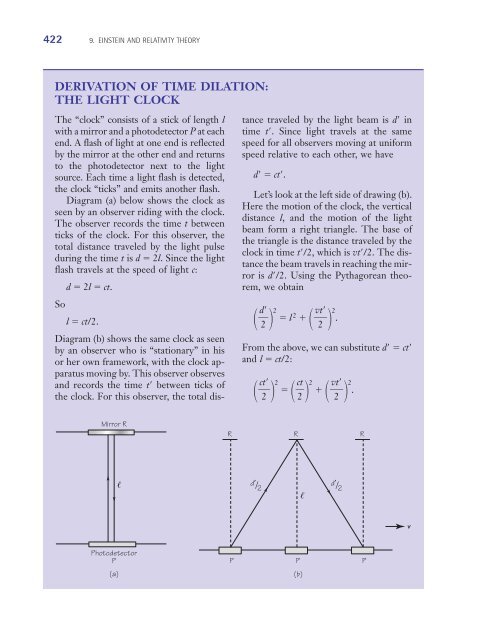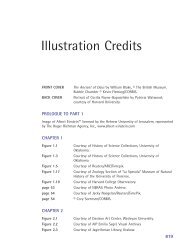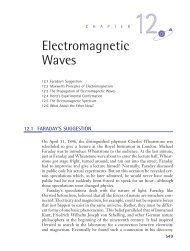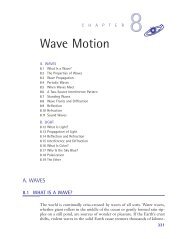Chapter 9: Einstein and Relativity Theory (319 KB) - D Cassidy Books
Chapter 9: Einstein and Relativity Theory (319 KB) - D Cassidy Books
Chapter 9: Einstein and Relativity Theory (319 KB) - D Cassidy Books
You also want an ePaper? Increase the reach of your titles
YUMPU automatically turns print PDFs into web optimized ePapers that Google loves.
3637_<strong>Cassidy</strong>TX_09 6/14/02 12:08 PM Page 422<br />
422 9. EINSTEIN AND RELATIVITY THEORY<br />
DERIVATION OF TIME DILATION:<br />
THE LIGHT CLOCK<br />
The “clock” consists of a stick of length l<br />
with a mirror <strong>and</strong> a photodetector P at each<br />
end. A flash of light at one end is reflected<br />
by the mirror at the other end <strong>and</strong> returns<br />
to the photodetector next to the light<br />
source. Each time a light flash is detected,<br />
the clock “ticks” <strong>and</strong> emits another flash.<br />
Diagram (a) below shows the clock as<br />
seen by an observer riding with the clock.<br />
The observer records the time t between<br />
ticks of the clock. For this observer, the<br />
total distance traveled by the light pulse<br />
during the time t is d 2l. Since the light<br />
flash travels at the speed of light c:<br />
d 2l ct.<br />
So<br />
l ct/2.<br />
Diagram (b) shows the same clock as seen<br />
by an observer who is “stationary” in his<br />
or her own framework, with the clock apparatus<br />
moving by. This observer observes<br />
<strong>and</strong> records the time t between ticks of<br />
the clock. For this observer, the total distance<br />
traveled by the light beam is d in<br />
time t. Since light travels at the same<br />
speed for all observers moving at uniform<br />
speed relative to each other, we have<br />
dct.<br />
Let’s look at the left side of drawing (b).<br />
Here the motion of the clock, the vertical<br />
distance l, <strong>and</strong> the motion of the light<br />
beam form a right triangle. The base of<br />
the triangle is the distance traveled by the<br />
clock in time t/2, which is vt/2. The distance<br />
the beam travels in reaching the mirror<br />
is d/2. Using the Pythagorean theorem,<br />
we obtain<br />
d<br />
<br />
2 l 2 .<br />
2<br />
2 2<br />
From the above, we can substitute dct<br />
<strong>and</strong> l ct/2:<br />
ct<br />
ct<br />
vt<br />
vt<br />
<br />
2 .<br />
2 2 2 2 2<br />
Mirror R<br />
R<br />
R<br />
R<br />
d ′ / 2<br />
d ′ / 2<br />
v<br />
Photodetector<br />
P<br />
P<br />
P<br />
P<br />
(a)<br />
(b)






